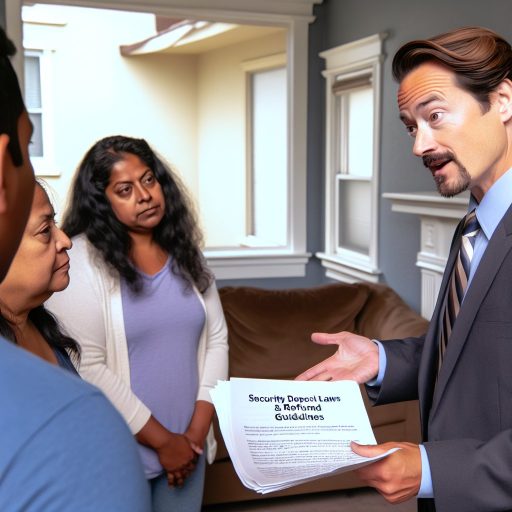Understanding Lease Agreements: Key Terms and Definitions
Importance of Lease Agreements
Lease agreements serve as a foundation for rental relationships.
They define the rights and responsibilities of tenants and landlords.
Ultimately, they provide legal protection for all parties involved.
Key Terms in Lease Agreements
Understanding the terminology is essential for both landlords and tenants.
Common terms include “lease term,” “security deposit,” and “terms of use.”
Familiarity with these terms helps avoid potential disputes.
Lease Term
The lease term refers to the duration of the rental agreement.
This period can vary, commonly lasting from six months to a year.
In some cases, month-to-month arrangements are also available.
Security Deposit
A security deposit is a sum paid upfront to cover potential damages.
This deposit often equals one month’s rent and is refunded at lease end.
Conditions for the return of this deposit must be clearly stated.
Terms of Use
Terms of use outline acceptable behavior during the lease period.
These rules may include restrictions on pets, noise levels, and property modifications.
Both parties must agree to these terms before signing the lease.
Types of Lease Agreements
Various types of lease agreements exist based on the nature of the tenancy.
Residential and commercial leases are the most common categories.
Each type has its unique provisions and legal implications.
Residential Leases
Residential leases pertain to renting living spaces.
They generally focus on tenant protection and property maintenance.
These leases often include clauses about repairs and tenant rights.
Commercial Leases
Commercial leases apply to business premises.
They often involve longer terms and higher financial stakes.
Negotiated terms can vary considerably based on business needs.
Breaking a Lease Agreement
Breaking a lease can lead to legal and financial consequences.
Valid reasons for breaking a lease might include job relocation or health issues.
Always consult the lease and local laws to avoid penalties.
Consequences
Consequences typically include losing the security deposit.
Landlords might also pursue the remaining rent as damages.
Understanding these implications is vital before taking any action.
The Legal Framework for Subletting: What Landlords and Tenants Need to Know
Understanding Subletting Agreements
Subletting involves renting out a property or part of it to another tenant.
This arrangement requires clear communication between landlords and original tenants.
Subletting agreements should include specific terms to protect all parties involved.
Both landlords and tenants must understand the legal implications of subletting.
Requirements for Subletting
Landlords often require tenants to seek approval before subletting.
This process typically involves submitting a written request to the landlord.
In some cases, landlords may charge an application fee.
Additionally, landlords may want to screen potential subletters.
Legal Obligations for Landlords
Landlords must provide tenants with a written policy on subletting.
They should outline any restrictions or conditions related to subletting.
Moreover, landlords must respond timely to subletting requests.
Failure to do so may lead to disputes between the landlord and tenant.
Legal Obligations for Tenants
Tenants must review their lease agreement for subletting clauses.
They should communicate openly with landlords about potential subletters.
Tenants must ensure subletter complies with the original lease terms.
Moreover, they remain responsible for the property condition during subletting.
Potential Legal Issues
Without proper agreements, subletting can lead to conflicts.
Tenants may face eviction if they sublet without permission.
Landlords might pursue legal action if terms are violated.
Thus, maintaining clarity in agreements can reduce potential disputes.
Key Takeaways
Clear communication is vital in subletting arrangements.
Understanding the specific legal framework protects both landlords and tenants.
Comprehensive agreements help avoid unnecessary conflicts.
Ultimately, all parties should seek legal advice if unsure about procedures.
How to Structure a Sublease Agreement
Essential Components
A sublease agreement is a crucial document for subletting tenants.
Start by clearly identifying the parties involved.
List the original tenant and the subtenant by full name.
Additionally, include their contact information for clarity.
Property Description
Next, provide a detailed description of the property.
Include the address and any specific unit number.
This ensures both parties understand the property involved.
Lease Duration
Specify the duration of the sublease agreement.
State the start date and the end date.
Make it clear whether the agreement is renewable.
Rent Payment Terms
Outline the rent amount and payment schedule.
Detail the due date for rent each month.
Include information on acceptable payment methods as well.
Security Deposit
Address the issue of a security deposit.
State the amount and the conditions for its return.
This section protects both parties in case of damages.
Utilities and Maintenance Responsibilities
Clearly define who pays for utilities.
List which utilities are included in the rent.
Also, detail the maintenance responsibilities of the subtenant.
Rules and Regulations
Incorporate any rules from the original lease.
These rules must also apply to the subtenant.
This includes pet policies, noise levels, and smoking restrictions.
Termination Conditions
Outline the conditions under which the agreement can be terminated.
Specify notice periods required for termination.
Clearly define what constitutes a breach of contract.
Signatures
Conclude the agreement with spaces for signatures.
Both the original tenant and the subtenant must sign.
Include dates next to the signatures for reference.
See Related Content: Property Inspections for Rental Properties
Tenant Rights and Responsibilities Under Subletting Arrangements
Understanding Tenant Rights
Tenants have specific rights when subletting their apartments.
These rights typically include the right to privacy and reasonable notice.
Moreover, tenants can expect the property to be maintained in good condition.
They must also receive a clear agreement outlining sublet terms.
Key Tenant Responsibilities
While tenants enjoy rights, they also carry responsibilities.
Firstly, they must obtain the landlord’s consent for subletting.
It’s crucial to ensure that the sublease complies with rental agreements.
Additionally, tenants should clearly communicate with their subtenants.
This communication includes rules about the property and shared spaces.
Maintaining Communication with Landlords
Regular communication with landlords is essential for tenants.
They should inform landlords about any potential subtenants.
Furthermore, it helps to arrange a meeting to discuss the arrangement.
Such transparency fosters a positive landlord-tenant relationship.
Understanding Lease Terms
Before subletting, tenants need to read their lease thoroughly.
Many leases contain clauses about subletting policies.
Violating these clauses can lead to penalties or eviction.
Thus, knowing the lease terms protects both tenants and landlords.
Establishing a Sublease Agreement
Creating a sublease agreement is a crucial step in the process.
This document should outline the duration and rent terms.
Additionally, it must specify responsibilities for property upkeep.
Both parties should sign the agreement for legal validity.
Furthermore, retaining a copy ensures all parties are informed.
Gain More Insights: How To Conduct Tenant Background Checks For Property Management Success
Negotiating Terms
Understanding the Essentials
Negotiating lease terms with subtenants is crucial for both parties.
It establishes clear expectations and responsibilities.
Moreover, it ensures compliance with local laws.
Setting the Ground Rules
Start by discussing the key aspects of the lease agreement.
Consider the duration of the sublet agreement.
Also, determine the monthly rent amount.
Identify any additional fees that may apply.
These could include utilities or maintenance costs.
Discussing Terms of Use
Clearly define the property usage policies.
Discuss whether pets are allowed on the premises.
Include rules regarding smoking and noise levels.
Furthermore, clarify guest policies and overnight visitors.
Considering Deposit and Damages
Discuss the security deposit upfront.
Set an amount that reflects potential damages.
Clearly outline what the deposit covers.
Be transparent about the process for returning the deposit.
Establishing Communication Protocols
Set communication expectations from the start.
Agree on how often you will meet or communicate.
Establish preferred methods of communication as well.
For instance, will you use email, phone, or in-person meetings?
Finalizing the Agreement
Once all terms are discussed, draft a written agreement.
Ensure both parties read and understand the document.
Each party should sign and retain a copy for their records.
This step solidifies your mutual understanding and agreement.
Gain More Insights: How to Create a Maintenance Schedule for Rental Properties

Common Pitfalls in Subletting: What to Avoid in Lease Agreements
Failing to Obtain Landlord Approval
Always seek official permission from your landlord before subletting.
Ignoring this step can lead to lease violations.
Ultimately, it may result in eviction or legal issues.
Neglecting to Draft a Sublease Agreement
A clear sublease agreement is essential for subletting.
Without it, misunderstandings about responsibilities may arise.
Include details about rent, duration, and house rules.
Underestimating Tenant Screening
Screen potential subtenants thoroughly before approval.
Check references, employment history, and rental history.
This process helps find reliable and trustworthy candidates.
Ignoring the Original Lease Terms
Be aware of the terms stated in the original lease agreement.
Some agreements may prohibit subletting entirely.
Violating these terms can have severe consequences.
Overlooking Maintenance Responsibilities
Clearly define maintenance responsibilities in the sublease.
Subtenants must understand their obligations for upkeep.
This prevents disputes regarding damages or repairs.
Not Addressing Deposits and Rental Payments
Make sure to establish clear payment terms.
Decide on deposit amounts and payment schedules.
Clear financial agreements promote smooth transactions.
Failing to Communicate with the Landlord
Maintain open communication with your landlord throughout.
This ensures that all parties are aware of the arrangement.
Transparency fosters trust and minimizes conflicts.
Uncover the Details: Red Flags To Watch For During Tenant Screening In Real Estate
Ensuring Compliance: How Landlords Can Protect Their Interests
Understanding Lease Agreements
Lease agreements set the foundation for rental relationships.
They clarify the rights and responsibilities of both landlords and tenants.
Landlords must ensure these documents are comprehensive and clear.
This helps prevent misunderstandings and disputes.
Key Elements of a Lease Agreement
A lease agreement should include essential details.
These include the rental amount and payment due date.
Additionally, it should specify the lease term and security deposit information.
Landlords should clarify rules regarding subletting options.
Subletting Permissions
Landlords should clearly outline subletting policies in lease agreements.
By doing this, they can control who resides in their property.
It’s essential to define the conditions under which subletting is allowed.
Landlords may require prospective subtenants to submit applications.
Conducting Background Checks
Background checks are critical in tenant screening processes.
Landlords should consider credit history, rental history, and criminal records.
This safeguards the property from potential damage and disruptions.
Furthermore, it helps ensure a reliable rental income.
Setting Clear Terms for Occupancy
Landlords must specify occupancy limits in lease agreements.
This prevents overcrowding and maintains property standards.
Clearly outline guest policies as well to avoid conflicts.
Enforcing the Lease Agreement
Landlords should consistently enforce lease terms across all tenants.
This establishes fairness and promotes compliance.
Regular communication with tenants can help reinforce these terms.
In cases of violations, landlords must document incidents thoroughly.
Legal Recourse for Non-Compliance
Landlords have legal options when tenants violate lease terms.
They can issue warnings or begin eviction proceedings as necessary.
It’s advisable to consult legal counsel when considering eviction.
This ensures compliance with local laws and protects landlord rights.
Best Practices for Managing Subletting Relationships
Understanding Subletting Agreements
Subletting agreements outline responsibilities for both tenants and landlords.
Firstly, they must clearly define the terms of subletting.
Additionally, these agreements should specify rental rates and duration.
Tenants should always seek written consent before subletting their apartments.
This action helps prevent misunderstandings and legal issues.
Communicating Openly
Clear communication fosters positive subletting relationships.
Tenants should regularly update landlords about any changes.
Moreover, landlords should ensure tenants feel comfortable raising concerns.
This transparency builds trust over time.
Screening Subtenants
Thoroughly screening subtenants protects all parties involved.
Landlords should request background checks and rental history.
Tenants, likewise, should assess potential subtenants’ reliability.
Consider asking for references from previous landlords.
Documenting Everything
Documentation is critical in a subletting arrangement.
Both parties should keep copies of the subletting agreement.
Recording payments and communications helps avoid disputes later.
Furthermore, it establishes a clear history of the arrangement.
Setting Expectations
Clear expectations help minimize conflicts between all parties.
Landlords should clearly outline house rules and policies.
Subtenants must be aware of these regulations from the start.
Regular check-ins can also clarify any misunderstandings.
Addressing Issues Promptly
Quickly addressing problems helps maintain a positive relationship.
Both landlords and tenants should communicate concerns ASAP.
Resolving issues promptly leads to fewer disruptions.
Moreover, timely communication encourages cooperation between parties.
Ending the Subletting Arrangement
Knowing how to end a subletting agreement is essential.
Both parties must understand the process to avoid confusion.
Tenants should provide adequate notice before termination.
Additionally, landlords should confirm the return of the unit’s condition.
Additional Resources
Ending the Lease – Landlord/Tenant Law – Guides at Texas State …




